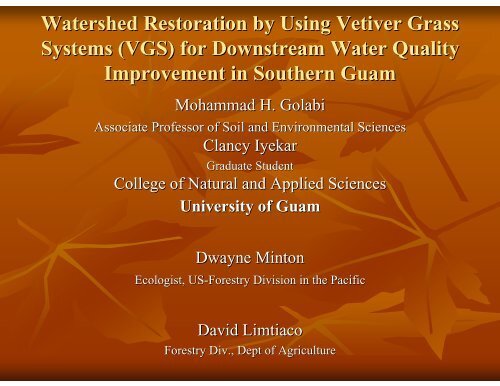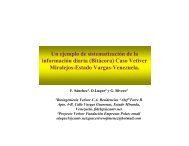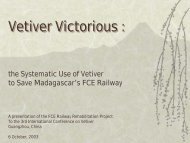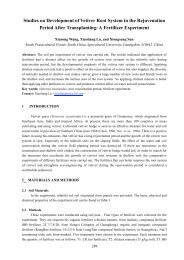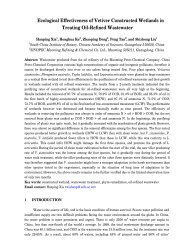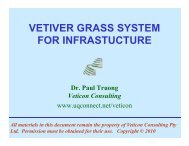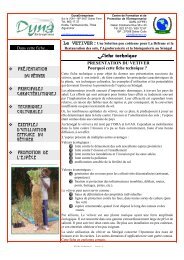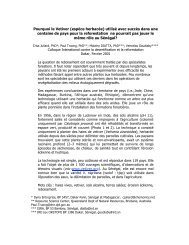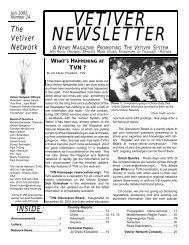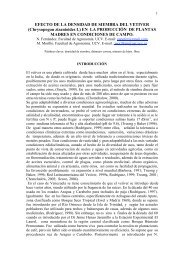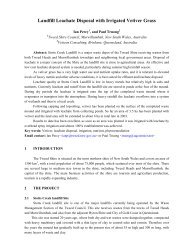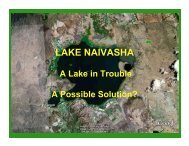Watershed Restoration by Using Vetiver Grass Systems (VGS) for ...
Watershed Restoration by Using Vetiver Grass Systems (VGS) for ...
Watershed Restoration by Using Vetiver Grass Systems (VGS) for ...
Create successful ePaper yourself
Turn your PDF publications into a flip-book with our unique Google optimized e-Paper software.
<strong>Watershed</strong> <strong>Restoration</strong> <strong>by</strong> <strong>Using</strong> <strong>Vetiver</strong> <strong>Grass</strong><br />
<strong>Systems</strong> (<strong>VGS</strong>) <strong>for</strong> Downstream Water Quality<br />
Improvement in Southern Guam<br />
Mohammad H. Golabi<br />
Associate Professor of Soil and Environmental Sciences<br />
Clancy Iyekar<br />
Graduate Student<br />
College of Natural and Applied Sciences<br />
University of Guam<br />
Dwayne Minton<br />
Ecologist, US-Forestry Division in the Pacific<br />
David Limtiaco<br />
Forestry Div., Dept of Agriculture
YU<br />
m<br />
as<br />
e<br />
he<br />
or<br />
-<br />
o?<br />
! H<br />
Se<br />
il<br />
gp<br />
Mn<br />
a<br />
iU<br />
lp
Typical badland in southern Guam<br />
M.H. Golabi
<strong>Grass</strong> burning is among the causes of soil<br />
degradation in southern Guam<br />
M.H. Golabi
Construction site<br />
Human Activities<br />
&<br />
Their effect on soil degradation in Southern Guam<br />
Burning<br />
Off reading<br />
Mismanaged farming
The Problem<br />
Soil erosion as the result of the burning and other<br />
human activities is the principle anthropogenic<br />
threat to the coral reefs in the Pacific Islands.<br />
Sediment loss due to erosion clogs rivers, lakes,<br />
waterways and more importantly damages the<br />
coral reef that is the major attraction <strong>for</strong> the<br />
tourist.<br />
• Sediment loss also reduces the water storage<br />
capacity of reservoirs and canals and increases<br />
flooding.
Challenges Facing Guam’s s Soil and<br />
Environmental Scientists<br />
Soil and environmental scientists and<br />
managers must develop strategies to<br />
control erosion on the farms, rangelands<br />
as well as the watershed areas<br />
New techniques must be introduced and<br />
examined <strong>for</strong> soil conservation and<br />
natural resources protection
Research Objectives<br />
Evaluate the effect of <strong>Vetiver</strong> grass to<br />
prevent sediment loss and control soil<br />
erosion at the watershed level<br />
Hence better the health of reef ecosystem<br />
of the Island.
Project Importance<br />
• <strong>Watershed</strong> Degradation<br />
• Water Quality Problems<br />
• Limited Water Sources<br />
• Coral Reef Degradation<br />
• Economic Impacts
Mud in Pauliluc Bay<br />
Courtesy of Dr. Minton, NPS
Healthy Coral Reef<br />
Courtesy of Dr. Minton, NPS
Coral Reef Degradation As the Result of Severe Soil Erosion<br />
Courtesy of Dr. Minton, NPS
<strong>Using</strong> <strong>Vetiver</strong> <strong>Grass</strong> <strong>Systems</strong> For :<br />
• Trapping sediment at the watershed level<br />
• Protecting downstream water bodies from<br />
sedimentation<br />
• Improving water quality entering the ocean<br />
• Protecting the Coral from smothering and<br />
dying
What Is <strong>Vetiver</strong> <strong>Grass</strong><br />
• Scientific Name: <strong>Vetiver</strong>ia Zizanioides<br />
<strong>Vetiver</strong> in Nature<br />
Seedlings
<strong>Vetiver</strong> Origin<br />
Mainly mass produced in Thailand<br />
Also found and Used In:<br />
* China * Indonesia<br />
* Australia * South Africa<br />
* Madagascar * Guam<br />
* Persia
Special Characteristics<br />
•Adoptable to Various Soil Conditions:<br />
* Low pH: < 4 * High pH: > 12<br />
• Able to take up heavy metals<br />
* Zn, As, Mn, Cu, Al, & Pb<br />
• Water Purifier (Sediment & Nutrients)<br />
* Nitrates & Phosphates
<strong>Vetiver</strong> Root System
Comparison between the common savanna Sword grass<br />
and <strong>Vetiver</strong> grass - Root systems<br />
Local Sword <strong>Grass</strong><br />
<strong>Vetiver</strong> <strong>Grass</strong>
Main Uses<br />
Badland<br />
Six Months after Planting<br />
China:<br />
Golabi
End Goal<br />
Stop Erosion From Source<br />
Stop Major Sediment Outfalls
Case Study<br />
Use of <strong>Vetiver</strong> Technology to control<br />
erosion as a watershed management<br />
strategy <strong>for</strong> water quality<br />
improvement and natural resource<br />
preservation
Methodology<br />
Four flumes (72ft X 5.5ft) are installed on a<br />
uni<strong>for</strong>mly sloped selected watershed area <strong>for</strong><br />
measuring the runoff and to estimate the<br />
sedimentation rate under four different<br />
treatments.<br />
Treatments are:<br />
1)‘as it is condition’,<br />
2)‘competently exposed condition’,<br />
3)‘burned’ and<br />
4) ‘<strong>Vetiver</strong> grass establishment’ as the<br />
sediment a trapping technique.
Methodology Cont’d<br />
Sets of suspended runoff/sediment samplers are<br />
constructed in a runoff-collecting tank placed at<br />
the bottom of each treatment plots <strong>for</strong> the<br />
measurement of sediment discharge as well as<br />
runoff assessment.<br />
Samples are used to measure the turbidity and the<br />
amount of sediment collected under each<br />
treatment.
Newly established <strong>Vetiver</strong> grass – Cross island road, S. Guam<br />
Golabi
Cross Island Road Project (4 treatments)<br />
Burned<br />
<strong>Vetiver</strong> & Sunnhemp<br />
Tilled<br />
Natural Cover
Flumes & Sampling Setup<br />
Flume Drain<br />
Sampling Design<br />
Sampling Protocol<br />
Tank Drainage
RESULTS
Initial soil characteristics<br />
Soil Texture<br />
(%)<br />
Management<br />
Practices<br />
Soil characteristics as affected <strong>by</strong> study<br />
treatments<br />
Soil Texture<br />
(%)<br />
O.M.<br />
(%)<br />
Clay Sand Silt Clay Sand Silt Avg. % O.M.<br />
3.9 54.4 24.9 20.7<br />
Burn 57.2 20.5 22.3 5.1<br />
3.9 54.4 24.9 20.7 <strong>Vetiver</strong> 51.8 28.2 20.0 5.4<br />
3.9 54.4 24.9 20.7<br />
Till 54.8 26.1 19.1 3.0<br />
3.9 54.4 24.9 20.7 Natural 56.8 25.7 17.5 3.8<br />
Table 1: Soil characterization prior and following the treatments.
Burn<br />
<strong>Vetiver</strong><br />
Tilled<br />
Natural<br />
30.0<br />
25.0<br />
20.0<br />
15.0<br />
10.0<br />
5.0<br />
0.0<br />
Soil Loss vs. Rainfall<br />
Average Soil Loss in Tons/Ha<br />
Feb 04'<br />
Mar<br />
Apr<br />
May<br />
Jun<br />
Jul<br />
Aug<br />
Sep<br />
Oct<br />
Nov<br />
Dec<br />
Jan 05'<br />
Feb<br />
Mar<br />
Apr<br />
May<br />
Jun<br />
20 7 9 4 74 32 74 31 21 21 9 5 10 1 0 4 16<br />
Average Monthly Rainfall in Centimeters
Size and slope of the study<br />
plots<br />
Area ha<br />
Length<br />
m Slope %<br />
Management<br />
practices<br />
(Soil surface<br />
conditions)<br />
Soil loss<br />
(tons/ha/yr)<br />
0.0037 21.95 12 Burn 14.13<br />
0.0037 21.95 12 <strong>Vetiver</strong> 1.47<br />
0.0037 21.95 12 Till 104.75<br />
0.0037 21.95 12 Natural 5.22<br />
Table 2 : Annual Soil loss from each plot with different treatments.
350<br />
300<br />
250<br />
200<br />
150<br />
Burn<br />
<strong>Vetiver</strong><br />
Tilled<br />
Natural<br />
100<br />
50<br />
0<br />
Run-Off vs. Turbidity<br />
Turbidity in NTU's<br />
Feb 04'<br />
Mar<br />
Apr<br />
May<br />
Jun<br />
Jul<br />
Aug<br />
Sep<br />
Oct<br />
Nov<br />
Dec<br />
Jan 05'<br />
Feb<br />
Mar<br />
Apr<br />
May<br />
Jun<br />
1.4 0.4 0.1 0.1 5.9 1.6 3.5 3.0 3.2 2.1 1.6 0.1 0.2 0.0 0.0 0.3 0.4<br />
Average Run-Off in Cubic Meters
Concluding Remarks<br />
• <strong>Vetiver</strong> Technology is viable system <strong>for</strong><br />
mitigating sedimentation at the watershed level<br />
<strong>for</strong> the water quality improvement and<br />
environmental preservation
Concluding remarks (cont’d)<br />
Preserving natural resources and<br />
Maintaining cleaner environment requires:<br />
• Highly coordinated holistic approach towards natural<br />
resource management that include:<br />
‣ Soil<br />
‣ Water<br />
‣ Rangelands<br />
‣ Forests<br />
‣ And watershed protection
Thank You<br />
Si yuus Maase


